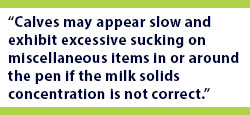
Calf Care Checklist: 5 Ways a Calf Tells You She’s Getting the Right Amount of Milk
 By Dr. Lucas Mitchell, Vita Plus calf and heifer specialist
By Dr. Lucas Mitchell, Vita Plus calf and heifer specialistHow do we know we are feeding our calves the proper amount of milk? It’s easy to rely on a milk replacer tag or chalk it up to “that’s how we’ve always fed calves.” But, ultimately, the calves hold the answer.
Similar to how we rely on the lactating herd’s performance to indicate if something is working or not, if we pay attention to how the calves are performing, they will show us if they are receiving too much, too little, or just the right amount of milk.
1. She is alert and perky with a shiny haircoat and good body condition.
When evaluating calves, don’t overlook their general appearance. A calf that is alert and perky with a nice, shiny haircoat is a healthy and happy calf. If a calf is holding her head low, her ears aren’t alert, and her coat seems dull and fuzzy, she likely isn’t feeling well. This may indicate a health challenge, which may be the result of feeding too little milk.
When calves aren’t consuming enough calories, especially early in life, it is more difficult for them to fight off disease. These symptoms may also indicate that milk replacer is being mixed at inappropriate solids concentration levels. Milk solids concentration should be between 12% and 15%, ideally near 13%. When solids are too high or too low, it can cause digestive upset and lead to calves exhibiting a poor general appearance.
It is also important to pay attention to the body condition of milk-fed calves. Calves that are receiving too little milk would be expected to carry little body condition and appear skinny, while those receiving too much milk will carry a lot of body condition and appear rounded over their withers, topline, and hips.
2. She has consistent, firm to soft manure.
Calf manure can tell us a lot about how much milk they are fed. We would like to see brownish, firm-to-soft manure on a consistent basis. A common sign of feeding too much milk is whiteish manure that has a pudding-like consistency. The whiteish appearance is indicative of incomplete digestion.
Loose to watery manure may indicate we are feeding too high of a milk solids concentration. Increased milk solids concentration leads to increased milk osmolality, which leads to water movement into the GI tract and loose, watery manure.
3. She is active and does not exhibit excessive non-nutritive oral behaviors.
When feeding calves, we expect them to be very active and at the front of the pen ready to receive the meal. Within one or two hours after feeding, we expect most calves to be lying down to rest. However, if we walk through at that time and calves are still very active and chewing/sucking on gates, buckets, panels, etc., it may indicate we are not feeding enough milk. If calves are satisfied after being fed, they should be ready to take a nice rest.
 Calves may appear slow and exhibit excessive sucking on miscellaneous items in or around the pen if the milk solids concentration is not correct. These behaviors may indicate the calf is not feeling well and trying to find some comfort.
Calves may appear slow and exhibit excessive sucking on miscellaneous items in or around the pen if the milk solids concentration is not correct. These behaviors may indicate the calf is not feeling well and trying to find some comfort.
4. She is consuming adequate amounts of calf starter.
Milk consumption and starter intake are highly correlated. The more milk a calf is fed, the less starter she will consume. We want to feed enough milk that it covers her needs through her first three weeks of life when starter intake is relatively low, but not so much milk that it delays when she gets into the feedbunk and starts consuming appreciable amounts of starter. Starter intake is critical for rumen development, which ensures that calves will continue to perform after weaning. Calves should consume 1 to 2 pounds of starter per day when they are four to six weeks old. If calves are not consuming this level of starter, we may be feeding too much milk.
5. She has desirable levels of growth.
Our goal in the preweaning period should be to maximize growth without sacrificing starter intake. We would like Holstein calves to gain at least 1.4 pounds per day through their first 60 days of life. At this level of growth, an 85-pound calf at birth should double its birthweight in 2 months. This is a reasonable growth goal and, if calves aren’t hitting this target, we may be feeding too little milk.
Talk to your local youngstock specialist to review your calf rearing program and ensure your calves are receiving just the right amount of milk. Pay attention to the calves and see how they are responding. When we feed the proper amount of milk to calves, we can expect healthier calves that consume more starter, grow better and are better prepared for life after milk.
| Category: |
Animal health Calf and heifer nutrition Starting Strong - Calf Care |

